Ecommerce Marketing: 33 Tips To Skyrocket Sales

I hope you enjoy this blog post. If you want Hello Bar to grow your leads, click here.
Author:
Ryan Bettencourt
Published
August 9, 2024

When it comes to ecommerce marketing, you have a lot of competition.
Your competitors are the dozens, hundreds, or even thousands of other niche ecommerce stores that sell products similar to yours.
So, how do you stand out from the competition? How can you build ecommerce sales quickly without resorting to unethical tactics?
We’re going to answer those questions and more. Let’s dig in.
What Is Ecommerce Marketing?
Ecommerce marketing is the process of attracting prospective customers to your ecommerce store, presenting them with offers, and convincing them to go through the checkout process. Sounds simple, right?
It’s not always the case. Ecommerce marketing requires you to thoroughly examine your branding, voice, product positioning, and marketing channels to get them all right.
That’s okay, though, because we’ll break it down step by step.
You May Also Like:
- 9 Strategies on How to Generate Leads from Your Website
- 11 Best B2B Lead Generation Strategies of 2024
What Is an Ecommerce Marketing Strategy?
An ecommerce marketing strategy is the steps you put into place to attract, convert, and delight your customers. It involves customer acquisition, of course, but it should also focus on lead nurturing and customer acquisition.
In other words, your ecommerce marketing strategy needs to involve the entire buyer’s cycle. Prospects visit your ecommerce site and sign up for your email list to become leads. You nurture them through solid emails until they convert into customers.
Your work’s not done, though.
After that, you continue to market to them so they return for more.
Email Marketing
Email marketing for ecommerce has proven to be one of the most distinct, effective, and cost-efficient ways to increase online sales and establish customer loyalty.
It involves sending targeted emails to potential and existing customers, such as feature promotional offers, product recommendations, and updates.
Studies show that effective email marketing can yield a high return on investment. On average, you can get $36 back for every dollar you spend.
One successful example of ecommerce email marketing is MCM. They effectively tackled cart abandonment by sending friendly reminders that say, “You left something behind.”
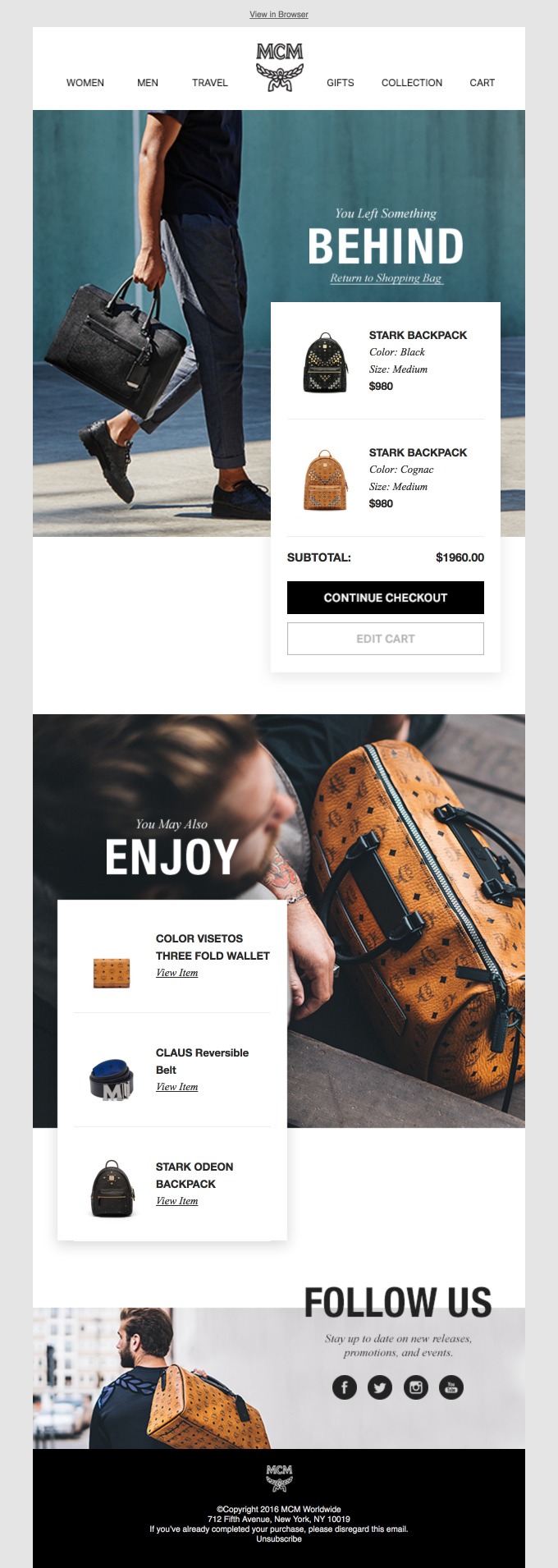
Image via ReallyGoodEmails
Such a simple yet compelling message urges shoppers to refrain from abandoning their carts and placing an order.
In this copy, MCM included a clear image of the abandoned product, a prominent call-to-action (CTA), and additional offers to incentivize customers. All these and the compelling sense of urgency make for a successful email marketing campaign.
Social Media Marketing
It’s hard to imagine a new business starting up these days without being on social media.
Social media ecommerce involves leveraging social media platforms to promote an online business, boost brand awareness, enhance visibility, expand the customer base, and drive sales.
Platforms like Facebook, Instagram, and TikTok allow businesses to showcase products, share user-generated content, and run targeted ad campaigns. If you’re creating marketing assets, such as promotional visuals for your campaigns, consider using a free flyer maker to design professional-quality flyers easily.
A prime example of successful social media marketing is GoPro’s “Million Dollar Challenge.” This campaign effectively transformed customers into brand ambassadors by encouraging them to share their adventurous experiences on social media.

Image via Jinnie’s Universities blogs
The initiative fostered community engagement and significantly boosted brand interaction. Since its inception, the campaign has become one of GoPro’s most successful marketing efforts, attracting 43,000 submissions globally.
You, too, can increase traffic and online sales by developing captivating content that resonates with your target audience. You can also use analytics from any top-rated social media marketing software to identify your customers’ wants and improve your strategy.
Interact with followers through comments and direct messages. This helps build a community, fosters trust, and raises brand awareness and sales potential.
SMS Marketing
SMS marketing has snowballed over the past few years and now accounts for an increasing share of ecommerce sales.
This type of marketing enables you to send texts to your contacts who have opted in. You can use SMS marketing to promote new products, services, or offers they cannot miss!
As more firms grasp the value of this channel, simply being there in a customer’s inbox will no longer suffice. Your SMS marketing must stand out.
Ensure your customers consent to receive SMS messages. Also, offer valuable content encouraging them to engage before sending SMS marketing.
Personalize messages, such as birthday discounts or reminders about abandoned carts, to improve customer experience and drive conversions. For this, use specialized software like SendPulse that lets you automate SMS sending in bulk or combine it with email.
For optimal results, keep your message short and include a simple call to action. Check out how Doomlings did it in their SMS marketing example below:
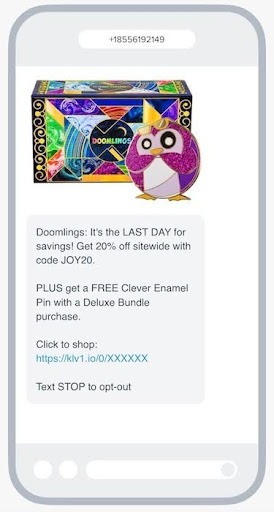
Image via Disruptive
The company wanted to inform its SMS subscribers of a sale. The goal was to create a sense of urgency to encourage last-minute purchases as the offer was about to end.
What is the outcome? The last day of the sale alone generated an impressive $1,500 in revenue!
You May Also Like:
Content Marketing
Content marketing is essential for attracting visitors to your website and creating awareness for your brand. This includes long-form writing, video, social content, and other creative content.
As customers navigate the buying process, you can build a good content pipeline that addresses their pain points, keeping them returning for more.
To implement a successful content marketing strategy, consider the following:
- Understand your audience: Identify your target audience’s preferences and interests to create content that resonates with them.
- Develop a content calendar: Plan and schedule content to ensure consistency and maximize reach.
- Choose the right channels: Distribute content across various platforms to reach your audience where they spend their time.
- Experiment with formats: Utilize different content formats (blog posts, videos, infographics, etc.) to cater to diverse preferences.
Simply put, prioritize the development of an ecommerce content strategy to help you meet your stakeholders’ commercial goals.
Paid Advertising
Paid advertising is a strategic approach for ecommerce businesses to increase visibility and drive targeted website traffic.
Platforms like Google Ads and social media ads allow brands to reach specific demographics and interests, maximizing the effectiveness of their campaigns.
To use paid advertising effectively, conduct thorough keyword research and create compelling ad copy highlighting unique selling propositions. A/B testing different ad formats and targeting options helps optimize campaigns for better performance.
By analyzing metrics such as click-through rates and conversions, you can refine your ecommerce marketing strategies and allocate budgets more efficiently, ultimately enhancing return on investment.
Affiliate and Referral Programs
Affiliate and referral programs are effective strategies for ecommerce businesses to leverage word-of-mouth marketing. They encourage customers and affiliates to share their positive experiences.
However, you need to establish well-defined guidelines and provide affiliates with comprehensive marketing materials for successful affiliate and referral programs. Also, track performance through unique referral links to measure success and optimize incentives.
Nurturing relationships with affiliates and loyal customers allows you to build a sustainable growth model that leverages community engagement and trust. Offering referral commissions, discounts, or other incentives enables brands to expand their reach and drive sales.
33 Pro Tips to Help Your Ecommerce Website Marketing Strategy and Skyrocket Sales!
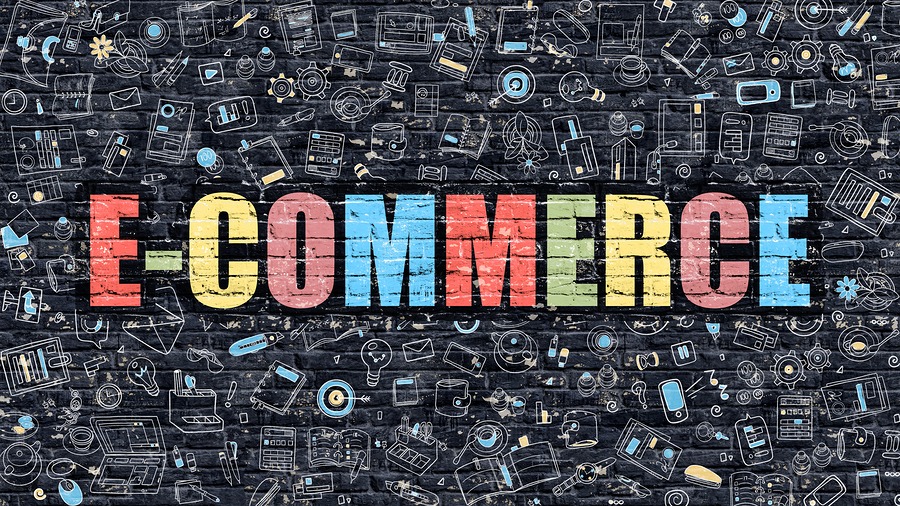
Now that we’ve gotten some definitions out of the way, how do you put ecommerce marketing into action? We’ve compiled 33 pro tips we have personally tested and found effective in boosting ecommerce sales and increasing ecommerce valuation.
Ready? Let’s begin.
1. Make Sure You Are Using Email Marketing From Day One
It’s not hard to successfully conduct email marketing when you have automated tools like Hello Bar at your disposal. For instance, you can create a top bar that invites website visitors to sign up for your email list. It’s always there, beckoning visitors to interact with it.

It’s that simple. You can also create exit popups to catch visitors as they’re about to leave.
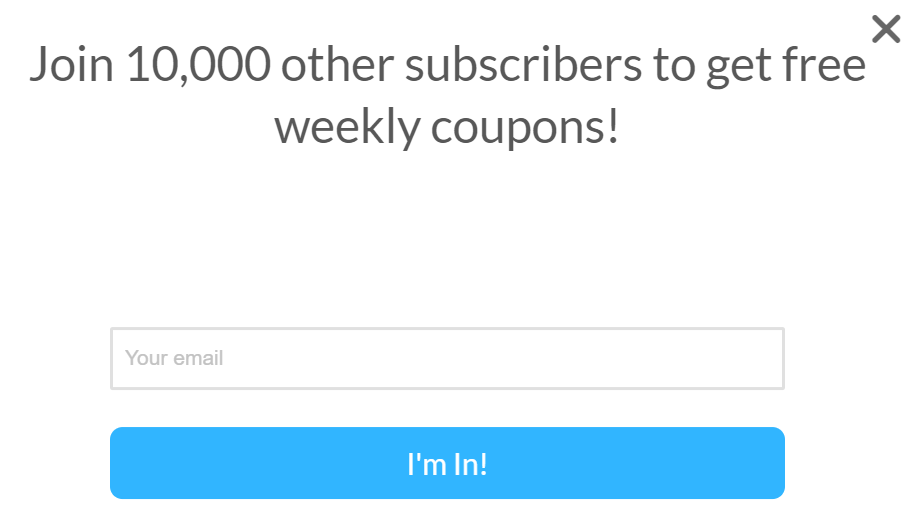
Using both simultaneously can make your ecommerce marketing more effective. As you collect emails, you bring leads into the fold so you can market to them directly. Sounds good, right?
2. Automate Your Ecommerce Email Marketing Campaign
If we can automate a task, we will. We have too many tasks on our plate to manually handle when we can automate them.
For instance, you can automatically send your marketing emails, social media posts, confirmation emails, thank-you pages, and more.
3. Use Social Media to Promote Your Content
A few days ago, we went shopping for a new mattress. We were still deciding whether to buy, but we wanted to know the options available.
Today, we logged into my Facebook account and saw this:

Clever, right? This is an example of remarketing ads, but we’ll discuss that later. The point here is that brands like Leesa use Facebook Ads because they work.
So do organic posts. If you can market your ecommerce products in a way that engages and resonates with your audience, you’ll see an increase in conversions..
4. Create Your Own Content — Do Not Copy or Reuse Others’ Content
We can’t stress this enough: Create your own content. Don’t take someone else’s words and claim them as your own.
Why?
It’s unethical, for one. It also opens you up to a lawsuit. Furthermore, nobody else’s content can match your unique brand voice. If you want to publish content, ensure it comes from your brain (or someone on your team).
4. Create your own content — Do not copy or reuse others’ content
This can’t be stressed enough: Create your own content. Don’t take someone else’s words and claim them as your own.
Why?
It’s unethical, for one. It also opens you up to a lawsuit. Furthermore, nobody else’s content can match your unique brand voice. If you want to publish content, make sure it comes from your brain (or from someone on your team).
5. Put a Lot of Effort Behind Your Branding
Branding sounds like a buzzword, but it’s not. It’s something you can’t avoid.
As soon as you go into business, you become a brand. You lose control if you don’t put effort into controlling and honing that brand.
People will make assumptions about your products or services. They’ll decide for themselves what you represent.
Don’t let that happen. Instead, get in front of the brand and mold it to your liking through visual branding and marketing. Use a logo generator AI or some other tools and services to improve visual branding and ensure everyone knows your unique selling proposition and reason for being in business.
You May Also Like:
6. Implement a Solid Loyalty Program to Bring Customers Back
Loyalty programs can have a fantastic impact on ecommerce marketing. They provide incentives to encourage regular use of your service or purchase of your products.
For instance, you might provide a $10 discount for every $100 spent. That might reduce your profit by 10 percent, but you can pick it back up in order quantities and total dollars spent.
7. Automate Some of Your Social Media Posts to Save Time
We’re big fans of Buffer. It allows you to schedule your social media posts days or weeks in advance.
Not only that, but it provides valuable insights into your social channels’ performance.

Schedule posts on Twitter, Instagram, LinkedIn, and other social platforms. This way, you can focus on ecommerce email marketing and offer incentives to encourage regular signups.
8. Create a Sense of Community Around Your Brand With Social Media
When people on social media see you as a social and relatable brand, they’ll become more interested in you. They might click on your links, reply to your posts, and otherwise engage with you.
Best of all, they might become subscribers. Give them an incentive to sign up once you’ve earned their trust and respect.
9. Constantly Interact With Your Customers and Leads on Social Media
Speaking of “earning,” you can’t just set up a Twitter account and expect to get followers. The same goes for all other channels. You have to actively engage with people if you want to get noticed, followed, liked, retweeted, etc. We have a great article about how to get more Twitter followers.
Start by replying to two or three people’s posts every day. Focus on your target audience, and don’t sell your products or services. Instead, provide encouragement or legitimate value.
10. Speak Your Customers’ Language

Everyone speaks in their own language — and we’re not talking about English versus Japanese. We mean the way people use words when communicating with people online.
Maybe you have a younger audience that’s accustomed to text speak. You could sprinkle a few obscure abbreviations throughout your ecommerce marketing content to encourage people to interact with you.
The point is to meet customers on their level. Don’t ever speak down or up to your audience. For businesses looking to enhance communication, tools like AI phone calls can help tailor interactions to individual preferences.
11. Do Not Forget About Mobile Optimization
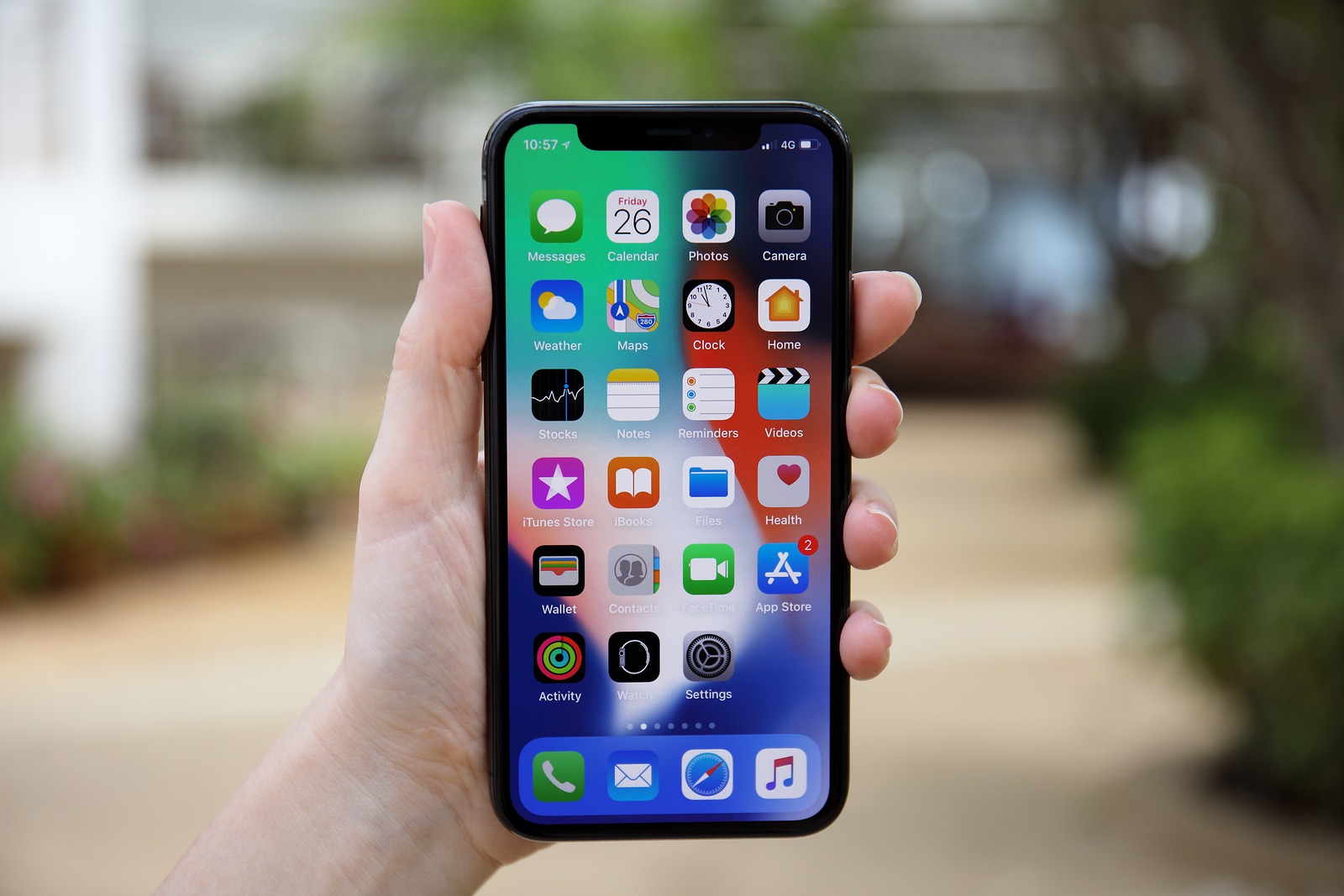
People are attached to their mobile devices all day and might only sit at a desktop or laptop for a few minutes.
Consequently, your ecommerce marketing must be mobile-friendly, from your website to your emails. Ensure your website has a responsive design and view your emails’ formatting on different device sizes before sending them out.
12. Create a Blog to Write About Interesting Topics in Your Niche and Generate More Traffic

Somehow, ecommerce professionals have gotten the idea that blogging is only for people who sell information products, services, or other non-ecommerce items. That’s simply not the case.
Want proof? Check out the Etsy Blog. It has amazing engagement and great advice. Plus, Etsy celebrates its community all the time — both its creators and its customers.
You’ll notice that Etsy uses multiple categories to help appeal to different segments of its audience, from the Featured Shop column to its DIY advice pieces.
13. Be Aware of What Is Going on in the World for Contextual Marketing
Let’s discuss newsjacking briefly. It’s the practice of taking a newsworthy topic and putting an industry spin on it.
The most famous example was Oreo Cookies. During the 2013 Super Bowl power outage, the company posted this tweet:
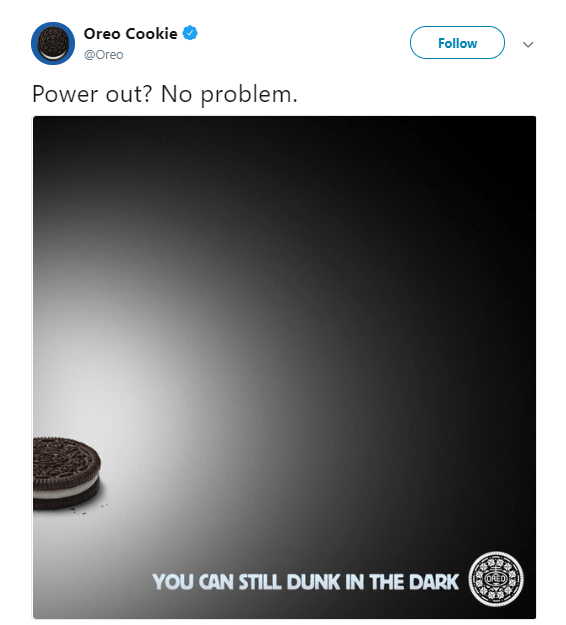
It received nearly 15,000 retweets and was featured all over the news.
As long as you’re tasteful, you can keep up with the latest news and trends and incorporate them into clever ecommerce marketing assets.
14. Create an Awesome Lead Magnet to Get More Leads for Your Ecommerce Business
If you think lead magnets are only for service and information businesses, think again. Like blogs, lead magnets help integrate customers further into your business and encourage them to buy.
If you sell kitchen gadgets for instance, you could create a guide describing 15 creative uses for a blender or some other device.
However, the content needs to be valuable and actionable. Include illustrations, recipes, and anything else that might provide extra value for the reader.
Then, use a Hello Bar to advertise it.

Easy, right?
You May Also Like:
- 21 Proven Exit Popup Formulas That Will Increase Conversion Rates
- Hello New Templates! Introducing Hello Bar’s Newest Email Collection Templates
15. Consider Using Free Shipping
Free shipping is another good incentive to use in your ecommerce marketing assets. Think about it. People can buy things in their own towns and not pay for shipping. Why should they add $10 to their bill if they don’t have to?
Add a minimum purchase price to your free shipping offer to reduce costs. More sales will make up for your outlay of shipping costs.
16. Use Videos to Help Your Customers “Visualize” Your Products Is a Great Ecommerce Marketing Idea
Video is becoming one of the most powerful marketing assets for all industries, especially ecommerce. Your customers can’t pick up your products off your virtual shelves, but you can provide an explainer video so the shopping experience becomes more visual.
Check out one of the latest LG product videos to understand what works.
You don’t have to match the production quality, but you can use the format as a guide.
17. Make How-to Videos on YouTube to Create a Deeper Connection With Your Audience and Potentially Get Their Emails
How-to videos can also help with ecommerce marketing. You could demonstrate how to use some of your products for specific goals.
You could also film yourself making recipes with the products you sell. Then, include links to the showcased product pages in your YouTube description section.
18. Only Use High-Quality Photos of Your Products to Optimize Your Ecommerce Marketing Efforts
Sticking with our kitchen theme, would you buy a product that’s represented like this:

Definitely not, right? It’s completely pixelated. It’s hard to even tell what it is.
Tack-sharp images are essential for selling ecommerce products. Ideally, you want a plain or white background with no distractions. If your product is small, use a macro lens to take a clearer shot.
19. Create a Solid SEO Marketing Strategy for Your Ecommerce Website
Yes, SEO matters when it comes to ecommerce marketing.
When you search for a product name on Google, you’ll get lots of results. You want yours to appear on the first page.
How? Conduct keyword research. A free tool like Ubersuggest can be incredibly helpful.
Use related keywords, too, and don’t forget to add ALT text to your images.
20. Let People Create Wishlists on Your Ecommerce Website and Remind Them About It With Email Marketing
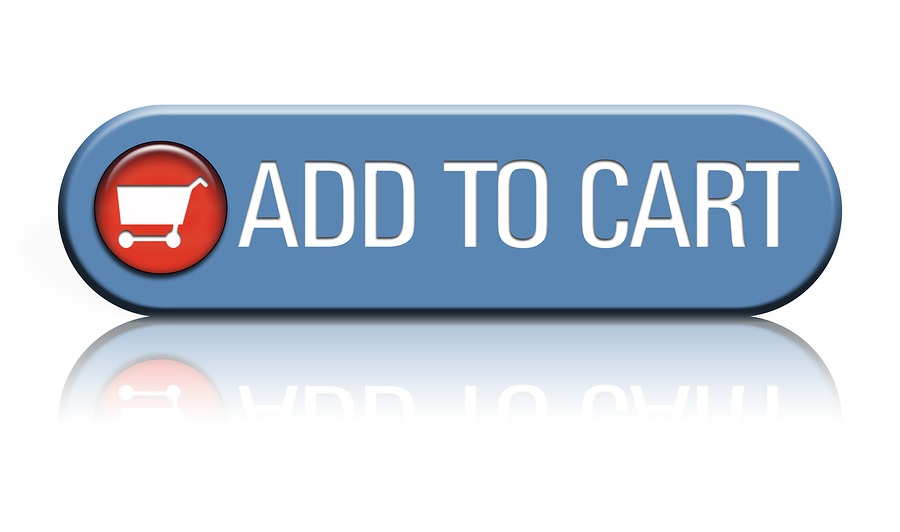
A wish list allows customers to bookmark products they might want to buy later. Although they may not have the cash right now, they plan to return at some point.
This is a great way to keep people snug in the buyer’s cycle. You can even send reminder emails to let them know they have items on their wish lists or to suggest similar products.
21. Put a Lot of Effort Into Conversion Rate Optimization to Maximize Ecommerce Marketing Efforts
Conversion rate optimization (CRO) refers to the process of optimizing the entire user experience (UX) for conversions. In other words, make converting as easy and attractive as possible.
You can do this using top bars.

Exit intents work really well, too.
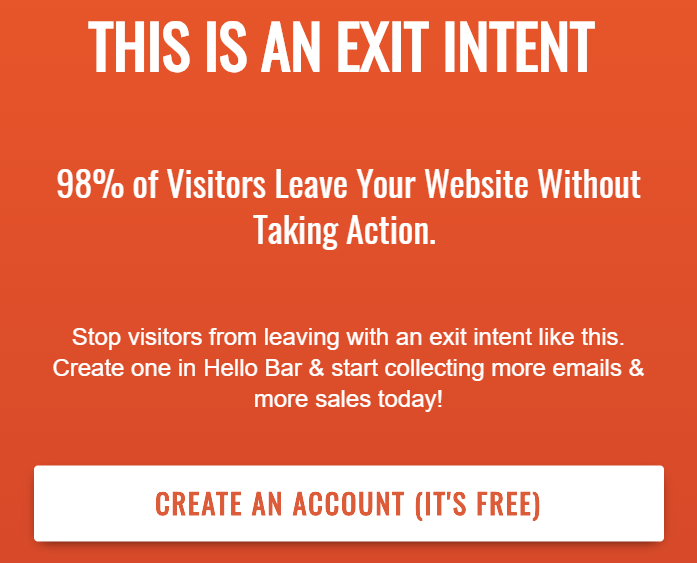
22. Optimize Your Ecommerce Website
A common issue we frequently encounter on ecommerce sites is the absence of effective navigation. We often find it difficult to locate the product we want.
Visit a few big ecommerce sites, such as Amazon and Wayfair, to see how they manage navigation. Figure out how to steal their formats, then customize them to suit your needs.
Adding breadcrumbs is a great way to keep people grounded. We use them on our blog here at Hello Bar:

The more ecommerce optimization you perform, the better your results.
23. Ask Your Customers for Reviews for Social Proof
Have you ever searched an ecommerce site for a particular product, then only clicked on the ones with a certain number of stars?
We do it all the time.
For instance, if we search on Amazon for “fidget spinner,” we get many results with different star ratings.
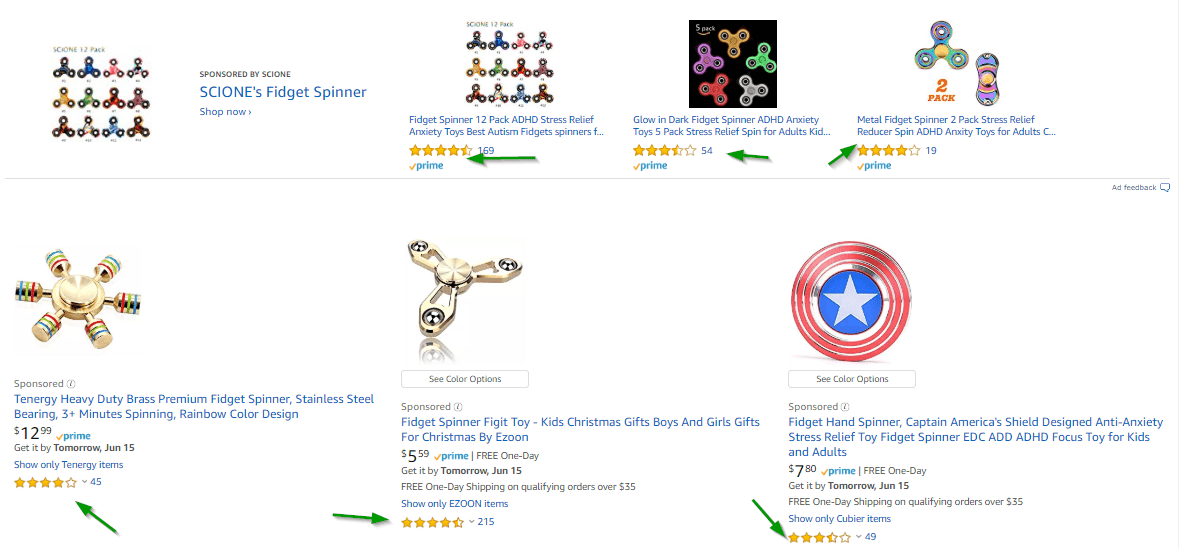
We might only click on the one with the highest star rating.
That’s social proof. You can also get social proof through written reviews. Customers are more inclined to review the products they purchase if you specifically invite them to.
24. Promote a Giveaway on Social Media

Want to crush the ecommerce marketing game? Offer a giveaway.
It’s one of the best ways to gain more social media followers and increase engagement. Plus, it can result in a huge sales boost.
Why? Because the people who didn’t win the product probably still want it. So, they might buy it. Even if only 20 people purchase your product because of the giveaway, you’ll still make money even though you’re sending one person the product for free.
You May Also Like:
- Customer Journey Maps – A Complete Guide to Help You Create Yours
- How Long Does It Take to Build a Website? Everything You Need
25. Use the Perfect Popups on Your Ecommerce Website With Hello Bar
Popups can help you generate more leads, conversions, and increase your ecommerce sales for your marketing campaign. Hello Bar can help, as we’ve already explained.
Try different types of popups to ensure you’re getting the most out of Hello Bar. For instance, an alert might work better than a page takeover.
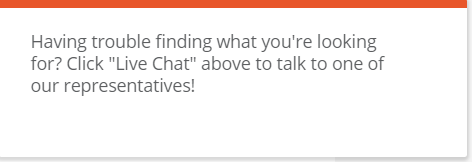
26. Consider Paid Social Media Ads for Your Ecommerce Marketing Strategy
Sure, it stinks to spend money on ads, but it can also produce excellent ROI. Facebook and Instagram are two of the most popular social ad networks.
Start with a low amount, then increase your spending based on the results. Remember to narrow your target audience as much as possible.
27. Consider PPC Search Engine Ads
PPC search engine ads can work just as well. You can even advertise in Gmail now if you want to get into people’s inboxes without email marketing.
28. Consider Social Media Influencer Marketing
Influencers don’t have to be expensive. Unless you want Kim Kardashian to promote your product, you can find niche influencers who charge a reasonable amount. You can even use an influencer marketing platform to identify and connect with influencers who perfectly fit your brand.
Some will even promote your product for free if they love it. Consider sending free samples to influencers in your niche.
29. Use Retargeting Ads! They Are Very Powerful!
A retargeting ad uses a pixel on your website that tells the ad network that a user has visited your site. The ad network then targets that user with an ad for your product.
Facebook retargeting ads are compelling. Since it has a large audience, Facebook can put your brand in front of a huge number of people. Plus, you can narrow your audience pretty far, so you’ll spend less cash.
30. Run Contests to Engage Your Followers and Also Promote Your Ecommerce Products

Contests can work just as well as giveaways. Ask people to send user-generated content to your social channels or email to enter. You’ll feature your favorite ones and send them freebies for participating.
Just remember that there are guidelines to follow when organizing contests, so ensure you check with the platform and consider the regulations of the countries where the participants reside. If you’re more comfortable with giveaways, which have far fewer rules, that might be the way to go.
31. Constantly A/B Test Your CTAs and Popups
Use Hello Bar to ensure you send the right messages at the right time. For instance, create two exit intent popups with a different CTA. We’ll automatically show them to equal parts of your audience.
Running constant A/B tests gives you data you can use to inform the rest of your ecommerce marketing campaign.
In other words, after you have a “winner” for your exit intent test, run another test with that exit intent against another one. This time, test the headline or body copy.
32. Offer the Best Customer Support in Your Industry

Want more cash? Be there for your customers.
Respond to emails, social media questions, and other communications within 24 hours. If you can respond within two hours, do it.
If someone asks for a refund, consider the request. You don’t want to irritate people who might spend money on your store in the future. In many cases, being lenient is less expensive in the long run.
Most importantly, respect your customers. No, they’re not always right, but they’re always human.
33. Create Customer Subscriptions
If you sell products that customers need to restock frequently, creating client subscriptions can greatly improve your ecommerce approach.
By switching to a subscription model, customers won’t have to worry about running out of things at the last minute. They can enjoy consistent delivery without having to worry about placing new orders.
Contact your consumers before important events for products that are frequently given as presents. In addition to increasing sales, being proactive in offering gift suggestions a month before major events like birthdays or anniversaries can greatly improve the customer experience.
You May Also Like:
- How to Build an Email List From Scratch: Start-to-Finish Guide
- 650+ Power Words List to Insanely Boost Conversions and Sales
How to Optimize Your Ecommerce Website?
Building and improving an ecommerce site is a job that always continues. Here are some strategies to optimize your ecommerce website for better performance and increased sales:
1. Make Your Store Easy to Navigate
To ensure visitors can easily find what they’re looking for, organize your store with clear and simple categories. For example, start with broad categories like “clothing” and then break them down into specific sections such as “t-shirts” and “jeans.” Add navigation aids, like “breadcrumbs,” to show customers where they are on your site and help them find their way back or explore other sections. A well-organized site keeps visitors engaged and improves how search engines view your store.
2. Incorporate Keywords on Product Pages
Keywords help search engines understand what your products are about and show your website to the right people.
When describing your products, use keywords naturally. For example, if you’re selling a cozy, oversized sweater, include phrases like “oversized knit sweater” or “soft, chunky sweater.”
Doing so helps search engines and gives customers a clear picture of your offerings. Focus on long-tail keywords and specific phrases people use when they’re ready to buy.
Instead of just “suits,” target “custom black suits.” These keywords are less competitive and attract customers closer to making a purchase.
3. Create Irresistible Product Listings
Your product pages are your virtual shop windows. Each product should have a unique and polished description highlighting its features and benefits.
Use descriptive language to convey the product’s qualities—words like “comfortable” and “durable” can paint a vivid picture for potential buyers.
Since online shoppers can’t physically interact with products, provide images with multiple angles and, if possible, a 360-degree view of the products.
Consider including lifestyle images or videos showing the product in use. Let customers imagine themselves using your product.
4. Go Beyond the Product Page
Don’t limit your content to just product pages; consider adding a blog to your ecommerce site. This can be particularly beneficial if you offer a variety of products.
For instance, if you sell scarves, creating content that guides customers through the process of choosing the right scarf can help them navigate their options without feeling overwhelmed.
A blog gives you another opportunity to use keywords and show your expertise in your niche. Whether you’re discussing fashion trends or providing tips on product usage, engaging content can attract more visitors and lead to higher conversion rates.
Plus, quality content can earn backlinks, further boosting your site’s visibility.
You May Also Like:
- Email Marketing For Beginners: A Complete Guide
- SEO For Lead Generation: How To Skyrocket Organic Leads
FAQs
Q1. What is the meaning of ecommerce marketing?
Ecommerce marketing is a way to promote a business that sells products or services online. Its goals are to increase traffic to the online store, convert visitors into paying customers, and keep them returning after a purchase.
Q2. What are the most effective channels for ecommerce marketing?
When choosing marketing channels for ecommerce, consider where your target audience spends time online and how they prefer to communicate. The most effective ecommerce marketing channels include paid ads on platforms like Google, Facebook, and Instagram, email marketing, social media marketing, and search engine optimization (SEO). Influencer marketing, affiliate marketing, and SMS marketing can also be highly effective.
Q3. How can I improve my ecommerce website’s conversion rate?
To improve your ecommerce website’s conversion rate, focus on creating a smooth user experience. Optimize product pages with high-quality images and compelling descriptions. Offer clear calls to action and multiple payment options. Regularly test and optimize your website to ensure ongoing improvements and effectiveness.
Q4.How much should I spend on paid media for marketing?
The amount of money you should spend on paid media marketing depends on your company goals, the audience you are trying to reach, and your available budget. Testing and refining your campaigns is something you should do once you have allocated funds in order to guarantee a great return on investment.
Q5. How important is setting up an abandoned cart series?
Setting up an abandoned cart is crucial for ecommerce businesses looking to recover lost sales and increase conversions. Abandoned cart emails are one of the most effective ways to re-engage potential customers. You can significantly reduce cart abandonment and boost your bottom line by sending timely, personalized reminders and offering incentives.
Conclusion
You now have 33 pro tips to improve your ecommerce marketing. From crafting compelling product listings to harnessing the power of social media, this guide offers a comprehensive roadmap to success.
Start by implementing one strategy and monitoring its impact on your results. Ecommerce optimization is a continuous process—consistent application and adaptation of these methods will lead to sustained growth.
Take the first step today, and watch your ecommerce business thrive.







